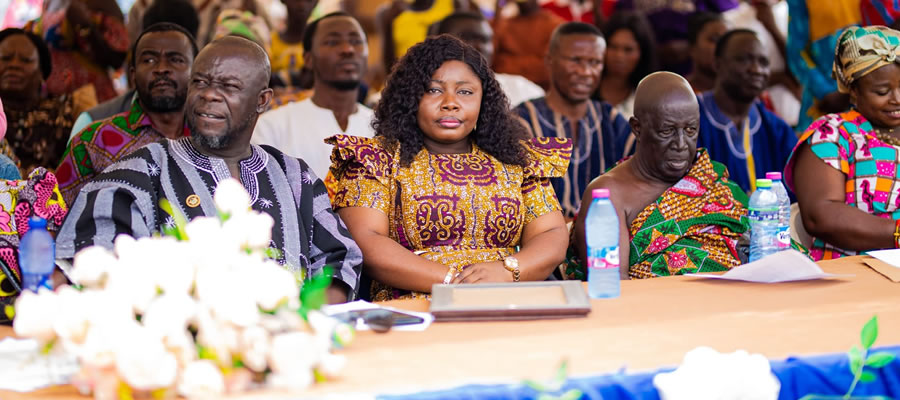

The day to day administration of education in the District is the responsibility of the Ghana Education Service. However, the District Assembly is basically responsible for the provision of infrastructure and the creation of an enabling environment for the progress of education in the District.
Table1.29: Educational Facilities in the District
NO. | LEVEL | NO. OF FACILITIES | ||
PUBLIC | PRIVATE | TOTAL | ||
1 | K. G. | 72 | 57 | 129 |
2 | Primary | 73 | 59 | 132 |
3 | Junior High School | 71 | 30 | 101 |
4 | Senior High School | 3 | 3 | 6 |
5 | Vocational | - | - | - |
6 | ICT | 4 |
|
|
7 | Library |
|
|
|
Source: GES Afigya-Kwabre, 2013/2014
The Table above shows a high access rate (i.e. 97%) to education in the District. There is also a high competition emanating from the private sector in terms of provision of education.
Ratio
Teacher – Pupil Ratio - 17:1
Teacher –Students Ratio - 25:1
The ratios show that Teachers are available in the District. This is partly attributed to its closeness to Kumasi and many other urban centers.
Table 1. 30: Percentage of School Going Population As Against The Unschooled.
POPULATION | PERCENTAGE |
SCHOOLED | 65 % |
UNSCHOOLED | 35 % |
| 100 |
Source: GES Afigya-Kwabre, 2013/2014
From the Table above, it can be seen that about 25% of children who are supposed to be in school are out of school. This is attributed to reasons like involvement in income generating activities and teenage pregnancy. Most of the young boys in the District work as drivers’ mates in especially ‘Trotro’
Circuits
There are eight education circuits in the District with specific and varied number of educational facilities as stated in Table 1. 22 below;
Table 1.31: Circuits and their Schools
NO. | CIRCUIT | K.G. | PRIMARY SCHOOL | JUNIOR HIGH SCHOOL |
1 | KODIE | 10 | 10 | 10 |
2 | ATIMATIM | 7 | 7 | 11 |
3 | ANKAASE | 11 | 11 | 9 |
4 | AHENKRO | 11 | 11 | 9 |
5 | BOAMANG | 10 | 10 | 9 |
6 | ABOABOGYA | 6 | 6 | 6 |
7 | TETREM | 9 | 9 | 8 |
8 | BUOHO | 8 | 9 | 9 |
TOTAL | 72 | 73 | 71 | |
Source: GES Afigya-Kwabre, 2013/2014
School Feeding Programme in the District
The Free Compulsory Universal Basic Education (FCUBE) took effect from the 2005/2006 Academic year, which gave all children free access to Basic Education.
In addition, a pilot Ghana School Feeding Programme (GSFP) was also initiated in 2005/2006 to give one hot meal per child in selected Basic Schools.
Table 1.32: Schools Benefitting from the School Feeding Programme
NO. | SCHOOL | ENROLMENT IN 2013 |
1 | Ankaase Methodist Prim. Sch | 480 |
2 | Nawase R/C | 451 |
3 | Ankaase S. D.A Primary School | 300 |
4 | Dumakyie D/A | 300 |
5 | Ankaase D/A Primary School | 450 |
6 | Hemang R/C | 396 |
7 | Kyekyewere D/A Primary Sch | 470 |
8 | Kyekyewere Meth. | 440 |
9 | Kyekyewere R/C Primary Sch. | 463 |
10 | Ejuratia Meth. | 390 |
11 | Amoako Methodist Prim. Sch. | 421 |
12 | Eeman Islamic | 300 |
13 | Akom D/A Primary School | 360 |
14 | Mpobi R/C ‘A’ | 304 |
15 | Nkwantakese Meth. Prim. Sch. | 304 |
16 | Mpobi R/C ‘B’ | 300 |
TOTAL | 5829
| |
Source: GES Afigya-Kwabre, 2013/2014
Date Created : 11/13/2017 7:00:06 AM












 facebook
facebook
 twitter
twitter
 Youtube
Youtube
 +233 593 831 280
+233 593 831 280 0800 430 430
0800 430 430 GPS: GE-231-4383
GPS: GE-231-4383 info@ghanadistricts.com
info@ghanadistricts.com Box GP1044, Accra, Ghana
Box GP1044, Accra, Ghana